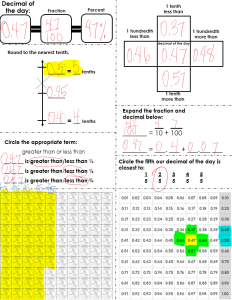A Decimal A Day
The old saying goes, "An apple a day keeps the doctor away."
We've taken that old adage and put our own mathematical spin on it. Here at Making Math Make Sense, we are huge advocates of Daily Number Sense Routines. Kristin and I started doing the penny-a-day activity many years ago with our students. Over time, we have revamped the activity to make it fit a variety of needs. Since we have shared this with teachers, we often hear how quickly their students develop a deep understanding of decimal place values. Kristin shares ways the activity can be differentiated once students develop the basic understanding, but the ideas have always lived in her head. Recently she was asked to finally put those ideas on paper, so of course, she turned to me.
What we came up with is the download below. Let's take a walk through this Daily Decimal Review.
To begin the Daily Decimal Review the teacher will roll 2 dice to generate the decimal of the day. It is best to use two 10-sided dice or place value dice if you have them. If you need some, check out our friends at Box Cars and One-Eyed Jacks. The various forms of the number go in the corresponding boxes. See example below.
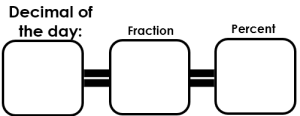
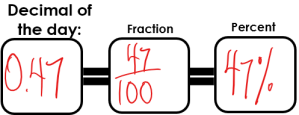
Students can complete the review in any order they wish, but moving onto the next portion you'll see the boxes that are similar to the boxes we use in primary grades when we ask for 1 more than, 1 less than, 10 more than, and 10 less than a number. Notice the vocabulary on these boxes. We are using tenths and hundredths. Place Value is key here. If students are struggling with this portion, we have included a decimal chart on the bottom right of this page.
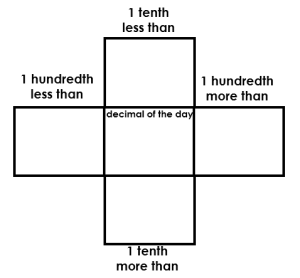
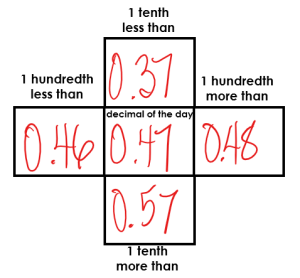
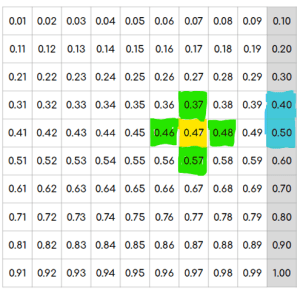
Having been in classrooms all around the country it's often we see whole numbers in expanded form. It's few and far between we see decimals or fractions in expanded form. Many, many times by the point in the year teachers are digging deep into decimals and fractions it's a hurry-up and get it taught lesson. When we slow down and work with place value of fractions and decimals like we do with whole numbers, the connections are made between their prior knowledge to the new content being taught. See the examples below on how I've expanded 47 hundredths. Tying it back to dimes and pennies is so helpful. We've provided a Penny chart on the bottom of the Daily Decimal Review page to help in the scaffolding of this instruction.
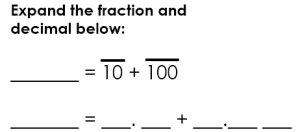
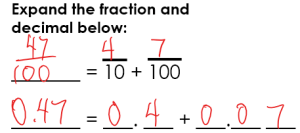
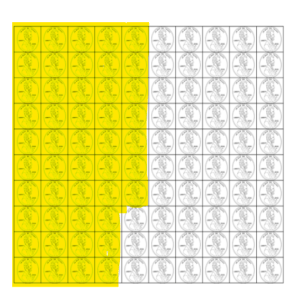
The next portion we will take a look at is Rounding to the Nearest Tenth. When we work with students and rounding, we do not want to teach them songs or tricks. We want them to have a conceptual understanding of numbers. When looking at 0.47 (forty-seven hundredths) we need to ask, "How many tenths are in our number?" We have 4 tenths in 47 hundredths. That's why we have written our numbers out in expanded form on the prior portion of this review. You can see at the bottom I have written four-tenths in unit form and in decimal form. When we write it in unit form (4 tenths) that allows your students to see the quantity and the value of the number we are talking about. (4 is the quantity, tenths is the value). You may also notice I wrote in the 0 for 40 hundredths so students can see that equivalency. We then need to ask the students, "What's 1 more tenth?" We are looking for 5 tenths and will then write it as a decimal as well. Students will have an easier time telling you the midpoint between 4 tenths and 5 tenths when the 0's are added in. Once the midpoint is stated, the students will mark an X where the number falls on the number line. The visual allows the students to see which tenth the Decimal of the Day falls closest to. Students can use the decimal board to help build this understanding. You will notice all the tenths are shaded light gray. Once students locate the decimal of the day, they can find which two tenths the number falls between.
If this is still difficult for your students, or if this is the first time you have worked on this skill, start by talking about dimes and pennies. If we have $0.47, how many dimes do we currently have? (4) What is the value of those dimes? ($0.40) If we had one more dime, how many would we have? (5) What would that value be? ($0.50) What is the halfway point between $0.40 and $0.50? ($0.45) Bringing in the connection of dimes with tenths and pennies with hundredths, really helps students visualize the numbers they are working with. The penny chart can be a reference for students to use during this section as well.
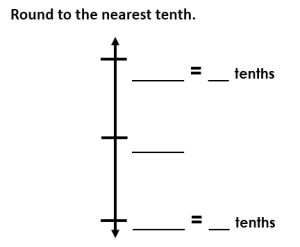

The last two portions of the Daily Decimal Review have students building connections between fractions and decimals. During the original penny-a-day activity, we quickly introduce the concept of 1/2 by drawing a line down the center of the chart. Students recognize that this shows the value of a half-dollar ($0.50). Daily we ask students to compare the daily amount to 1/2. Most students find this pretty easy since they are comfortable with knowing a half-dollar is equivalent to 50 cents. We then think about what else we know about money, and students talk about quarters. Knowing that 4 quarters make a dollar, and each quarter is worth $0.25, we draw lines on our penny chart to represent 1/4 and 3/4. Using the connection students have made between money, decimals, and fractions, during this section of the Daily Decimal Review, students will determine if our Daily Decimal is greater than or less than 1/4, 1/2, and 3/4.
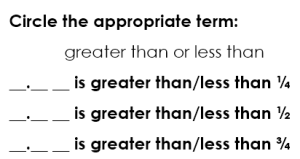
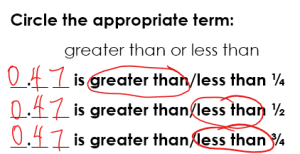
Building upon students' understanding of comparing benchmark fractions and decimals, the last section takes it up a notch by looking at fifths. Understanding the relationship between fifths, decimals, and percents is something many adults struggle with. However, when looked at on the penny chart, it becomes very clear to students how to work with these numbers. Once you have identified that ten pennies equal one dime, or ten-hundredths is equivalent to one-tenth, build upon that knowledge by looking at different ways you can group your tenths equally. We can group 5 tenths together to make 1/2, and we can group 2 tenths together to make 1/5. Kristin likes to circle the two groups of tenths on the penny chart as a visual for students. This allows students to see 1/5 = $0.20, 2/5 = $0.40, 3/5 = $0.60; 4/5 = $0.80, and 5/5 = $1.00. 6th-grade teachers also find this very useful when building an understanding of percents. In the last part of the Daily Decimal Review, students will use their conceptual understanding of 5ths (arranged strategically similarly to fractions on a number line) to circle which fifth is closest to the Daily Decimal. In this example, our Daily Decimal is only 7 hundredths away from 2 fifths, or $0.40, or 4 tenths, or 40 hundredths.


Kristin and I are super excited to share with you our latest version of the Daily Decimal Review. We hope it will be helpful to you and your students as you continue working with decimals and fractions throughout the school year.
